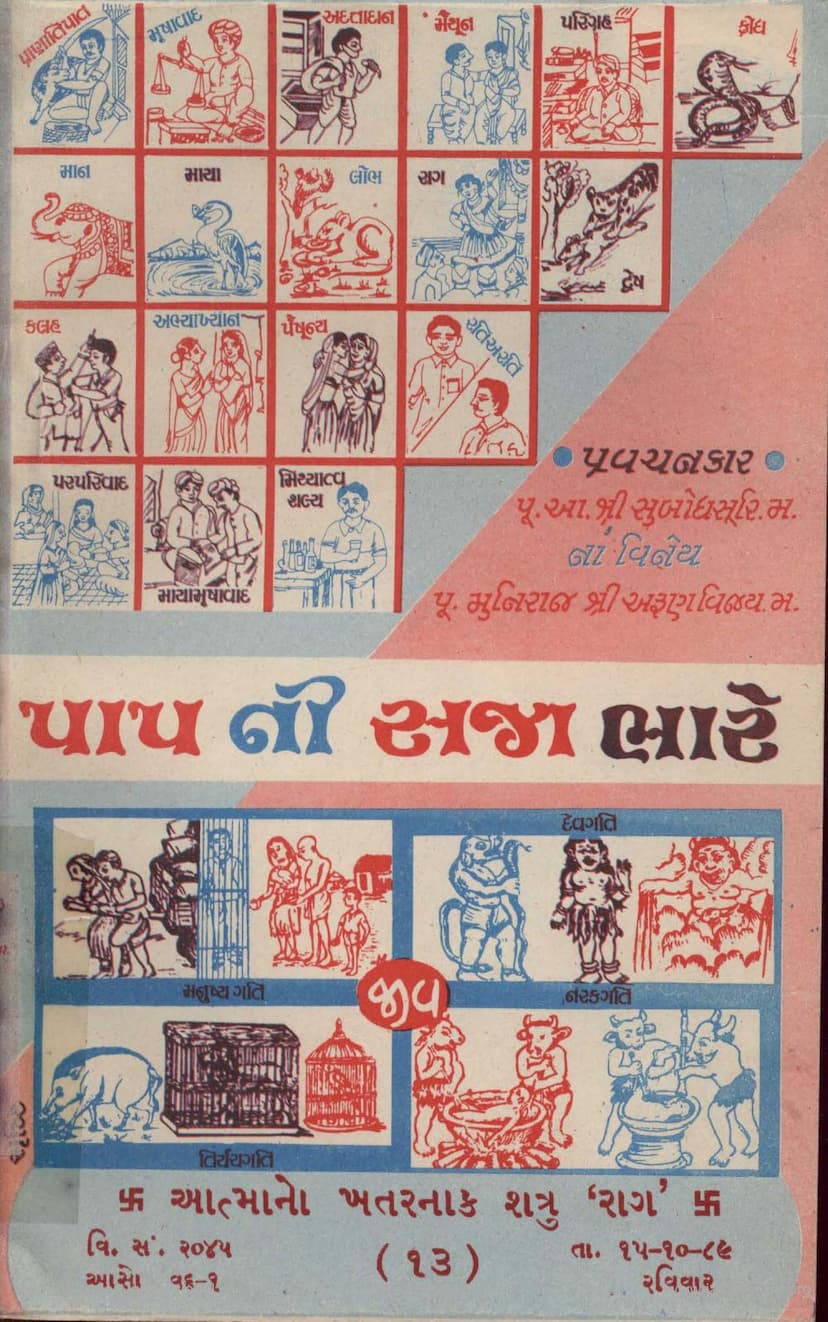Papni Saja Bhare Part 13
Added to library: September 2, 2025

Summary
Here is a comprehensive summary of the Jain text "Papni Saja Bhare Part 13" by Acharya Vijay Subodhsuri and Muni Arunvijayji, based on the provided text:
This book is the thirteenth installment in a series discussing the "ten sinful activities" (Das Pap Sthanak) from a Jain perspective, focusing this time on "Raag" (Attachment/Desire). The core message is that attachment and desire (Raag) are the soul's most dangerous enemies, leading to suffering and the cycle of birth and death.
Key Concepts and Themes:
- Raag and Dwesh as Seeds of Karma: The text quotes the Uttardhyayan Sutra, stating that attachment (Raag) and aversion (Dwesh) are the seeds of karma. Karma, in turn, arises from delusion (Moh) and is the root cause of birth, death, and suffering.
- The Two Fundamental Substances: The universe is fundamentally composed of two substances: Jada (inert/non-living) and Chetana (living/soul). All other classifications (like the six substances or five astikayas) ultimately fall within these two. The interaction and separation of Jada and Chetana constitute the cycle of worldly existence (Sansara).
- Karma Formation: Inert matter, specifically subtle particles called "Kaman Vargana" (karma-forming particles), are attracted to the soul through the "stickiness" of attachment and aversion (Kashayas). These particles then transform into karma, binding to the soul like milk and water. Karma follows the soul through different lives, relentlessly bringing about its results.
- The Soul's True Nature: The soul is inherently pure, possessing infinite knowledge, perception, bliss, and power. It resides in the eternal abode of Moksha. The text emphasizes that the soul is an indestructible, indivisible, and unchanging substance.
- The Soul's Capacity for Contraction and Expansion: The soul has the unique ability to contract and expand its infinite number of soul-substance-regions (Pradesh) to fit into the smallest or largest bodies. This is highlighted in the context of "Ananta Kaya" (infinite-bodied substances like roots and tubers), where many souls reside in a single body, and consuming them leads to the violence of infinite souls.
- The Cycle of Sansara: The soul is bound in Sansara due to its union with karma. The goal is to achieve separation from karma (Vichcheda), which is Moksha. This process involves stopping the influx of new karma (Samvara) and eliminating existing karma (Nirjara).
- Raag as the Root Cause of Suffering: The text repeatedly emphasizes that Raag (attachment and desire) is the primary cause of bondage and suffering. It obscures the soul's true, pure nature, leading it astray from its path to liberation.
- The Eight Kinds of Karma: The eight soul qualities are covered by eight types of karma, which act as veils:
- Infinite Knowledge (Jnanavarniya)
- Infinite Perception (Darshanavarniya)
- Infinite Conduct (Mohaniya) - This is particularly highlighted as the root of attachment.
- Infinite Power (Antaraya)
- Formlessness/Non-corporeality (Namkarma)
- Incorporeality/Lightness/Heaviness (Gotrakarma)
- Infinite Bliss (Vedaniya)
- Indestructible State (Ayushyakarma)
- Mohaniya Karma's Deceptive Nature: Mohaniya karma (delusion karma) is likened to intoxicating substances like alcohol. It makes the soul forget its true self, leading it to believe that happiness lies in external material possessions, wealth, and relationships. This creates attachment (Mamata) and ego (Ahankar).
- The "I" and "Mine" Mantra: The core of Moh (delusion) is the belief of "I" and "Mine" (Aham-Mam). This internal dialogue, in various languages, perpetuates the cycle of Sansara and traps the soul.
- The "Nahn-Marm" (Not I, Not Mine) Mantra: To escape this trap, the antidote is to negate these concepts: "Not I, Not Mine" (Nahn-Marm). By cultivating detachment, one can overcome Moh.
- The Cycle of Raag and Dwesh: The text illustrates how Raag can transform into Dwesh (aversion) when desires are unfulfilled, leading to conflict and further suffering. The cycle of Raag and Dwesh is the driving force of Sansara.
- Examples of Raag's Devastating Effects: Numerous stories and examples are provided, including:
- The attachment of Lord Rishabhdev in a previous life (as Lalitang Dev) to a goddess, leading to his fall from a celestial realm.
- The story of Dhanada Seth and his son, whose intense attachment to wealth led to their deaths and rebirths as animals (snake, mongoose, kite).
- The examples of Muni Sthilbhadra and Nandishen, who, despite their spiritual achievements, were temporarily swayed by worldly attachments (prostitutes), but eventually regained their spiritual path.
- The story of Muni Ashadhabhuti falling prey to a desire for sweets.
- The cautionary tales of attachment leading to attachment to even inanimate objects in celestial realms, resulting in rebirth in lower forms of life (like mineral substances).
- The Nature of Raag: Raag is described as a "slow cold poison" that gradually destroys the soul's true nature. While Dwesh (aversion) is immediately destructive, Raag's effects are insidious and long-lasting.
- The Importance of Detachment (Tyag) and Faith in the Vitaraag: The text strongly advocates for detachment from worldly desires and attachment to virtuous beings and principles (Vitaraag, Viragi, Saints, and the teachings of Jainism). Cultivating attachment to these is considered "Prashasta Raag" (praiseworthy attachment), which helps in spiritual progress.
- The True Meaning of Worship: Worship of the Arhats (Vitaraag Lords) should be for the destruction of desire and attachment, not for worldly gains. Praying for more worldly pleasures only increases the cycle of Sansara.
- The Path to Liberation: True liberation is achieved by eradicating Raag and Dwesh, thereby breaking free from the cycle of karma and rebirth. This is the path of the Vitaraag (those who have conquered attachment and aversion).
In essence, "Papni Saja Bhare Part 13" serves as a profound warning against the destructive power of attachment and desire, urging readers to understand the soul's true nature and strive for detachment to achieve liberation from suffering.